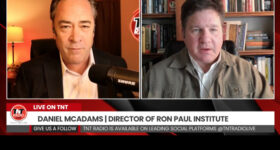Editor’s Note: With the Dodd-Frank Act coming into effect, over the counter trading of gold and silver may be illegal starting on July 15th (or at least that is what some companies apparently now believe). FOREX sent out the following cable last week:
“We wanted to make you aware of some upcoming changes to FOREX.com’s product offering. As a result of the Dodd-Frank Act enacted by US Congress, a new regulation prohibiting US residents from trading over the counter precious metals, including gold and silver, will go into effect on Friday, July 15, 2011… We encourage you to wind down your trading activity in these products over the next month in anticipation of the new rule, as any open XAU or XAG positions that remain open prior to July 15, 2011 at approximately 5:00 pm ET will be automatically liquidated.”
We shall see. But could a future change in trading laws contribute to a recent flight from Gold Mining shares?
–
By JOHN RUBINO
Dollar Collapse
June 19, 2011
Conventional wisdom — backed up by years of observation — states that gold mining shares tend to outperform the underlying metal in good times because they’re “leveraged to the price of gold.” That is, their extraction costs are more-or-less fixed, so when gold rises, most of the increase flows directly a miner’s bottom line, increasing its earnings at a rate that exceeds the metal’s move.
With gold near a record, most miners should put up ridiculous earnings in the year ahead, which should make their shares act like tech circa 1998, right?
Nope. The biggest miners, whose shares populate the GDX gold miner ETF, did outperform gold (represented here by the GLD ETF) during most of its recent epic run, just as you’d expect. But in April the two trends diverged, and lately the divergence has become a chasm. Gold is up 22% in the past 12 months and the big miners are, as a group, virtually unchanged.

This is painful and humbling for investors who bet on gold by loading up on mining shares, only to discover that they were right on the macro but wrong on the implementation. But one person’s pain is another’s opportunity, and the market appears to be offering a whopper here.
Assuming that the long-term relationship between gold and the miners holds — and there’s no reason to think it won’t — then the trend lines will converge at some point in the coming year. This can happen in several ways: They can both fall, but gold more than mining shares. They can both rise, but mining shares can rise more. Or gold can tread water while the miners go up.
Which means there are two ways to play it: Buy the miners and ride them, which will work if gold goes up. Or short gold and buy the miners, in which case you don’t care where gold goes as long as the miner/metal relationship reverts to normal. The first is simpler but only works in a rising gold price scenario. The second is an arbitrage that should work no matter what gold does in the year ahead, though it carries an emotional price, since shorting gold is disturbing on a lot of levels.
On the other hand the idea of making money while being short gold — in the middle of a global currency meltdown — has a certain contrarian appeal.
One final thought: If the big miners are underperforming because of fears that they can’t replace the reserves they’re consuming, then we’re in for a buyout binge as they use their rising cash flow to gobble up the juniors with the most accessible reserves. So the small-cap miners will end up being the best part of this market.
–
















